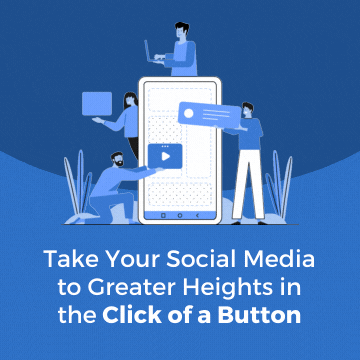In our current social media landscape, likes and shares are often seen as the benchmarks of success on social media. However, for businesses aiming for a substantial ROI, understanding the deeper value of social media engagement is crucial. This blog explores how businesses can move past these surface-level metrics to uncover the real impact of their social media strategies on ROI.
SUMMARY
- The True Impact of Social Media Engagement
- What are Key Metrics You Can Use to Measure Engagement Effectively?
- The Ripple Effect of Quality Engagement
- Leveraging Social Listening for Deeper Insights
- The Power of User-Generated Content
- Influencers and Engagement
- Frequently Asked Questions
- A Final Word on Social Media Engagement
Social media platforms offer a plethora of data, but it's easy to get caught up in the vanity metrics. While likes and shares are straightforward and gratifying to track, they don't paint the full picture of the effectiveness of your social media strategy. The true value of social media engagement lies in how it influences consumer behavior, builds brand loyalty, and drives conversions.
To truly gauge the impact of your efforts, it's essential to look at a broader set of metrics and understand what they signify for your business. Engagement rates, customer sentiment, and conversion rates provide a more comprehensive understanding of how your content is resonating with your audience. This deeper dive into analytics can reveal insights about your brand's perception, the effectiveness of your messaging, and how your social media presence contributes to your overall business goals.
Moreover, the quality of engagement matters significantly. A smaller number of meaningful interactions, such as detailed customer feedback or shares within niche communities, can be more valuable than a large number of likes. These quality engagements can lead to stronger customer relationships, enhanced brand loyalty, and, ultimately, a higher ROI.
This blog aims to guide you through the nuances of social media engagement, helping you look beyond the surface to leverage the full power of even the most popular platforms. So what are we waiting for? Let’s DIVE IN!
The True Impact of Social Media Engagement.png?width=338&height=338&name=social%20media%20engagement(1).png)
Engagement on social media extends far beyond likes and shares; it's a multifaceted measure of how your audience interacts with your content and brand. This deeper level of engagement encompasses a variety of actions, each offering unique insights into customer behavior and preferences.
- Comments: Comments are a goldmine of qualitative data. They provide direct feedback from your audience about what they like, dislike, or wish to see more of. Analyzing comments can help you understand your audience's pain points, preferences, and perceptions about your brand.
- Shares: When someone shares your content, it's a strong indicator that they found it valuable enough to pass along to their own network. Shares can exponentially increase your content's reach and are a sign of content that resonates deeply with your audience.
- Direct Messages: Direct messages can be a direct line to your customers' thoughts and are often where more detailed, personal interactions occur. These interactions are crucial for building one-on-one relationships and can provide insights into customer service issues, product inquiries, or general feedback about your brand.
- Mentions: Mentions, whether tagged or untagged, show that your brand is part of a larger conversation. Monitoring mentions can help you gauge your brand's presence in the social media landscape and identify opportunities for engagement or reputation management.
- Video Views and Watch Time: For content like videos, metrics such as the number of views and average watch time are essential to understand how engaging your content is. High watch time can indicate that your content is captivating and holds the audience's attention.
- Profile Visits and Link Clicks: These metrics indicate that your content is compelling enough to prompt users to seek more information about your brand. High numbers in these areas can signal strong interest in your products or services and lead to higher conversion rates.
Each of these engagement types offers valuable insights into how your audience perceives and interacts with your brand. By analyzing these metrics, you can tailor your social media content strategy to better meet the needs and interests of your audience, leading to a more effective social media presence and a stronger impact on your ROI.
 What are Key Metrics You Can Use to Measure Engagement Effectively?
What are Key Metrics You Can Use to Measure Engagement Effectively?
1. Engagement Rate
2. Conversion Rate
3. Customer Sentiment Analysis
4. Click-Through Rate (CTR)
5. Bounce Rate and Time on Site
6. Share of Voice
To effectively measure the impact of your social media engagement, it's essential to focus on specific metrics that delve deeper into audience interactions. These metrics provide a more comprehensive view of how well your content resonates with your audience and drives business results.
.png?width=464&height=464&name=social%20media%20engagement(2).png)
#1 Engagement Rate
Engagement rate is a crucial metric that measures the level of interaction your content receives relative to your number of followers or reach. It's calculated by taking the total number of engagements (likes, comments, shares, etc.) and dividing it by the total number of followers or reach, then multiplying by 100. A higher engagement rate typically indicates more relevant and compelling content for your audience.
#2 Conversion Rate
Conversion rate is a critical metric for businesses focused on ROI. It measures the percentage of social media interactions that lead to a desired action, like a website visit, newsletter signup, or purchase. This metric helps you understand how effectively your social media efforts are driving tangible business results.
#3 Customer Sentiment Analysis
This involves analyzing the emotions and attitudes expressed in social media interactions about your brand. Tools for sentiment analysis can categorize mentions into positive, negative, or neutral. Understanding sentiment can help you gauge public perception of your brand and identify areas for improvement or opportunities to capitalize on positive sentiment.
#4 Click-Through Rate (CTR)
CTR measures how often people click on the links included in your posts. A high CTR indicates that your content is not only engaging but also effective in encouraging viewers to take a desired action, like visiting your website or checking out a product.
#5 Bounce Rate and Time on Site
For traffic coming from social media, monitoring the bounce rate and the average time spent on your site can provide insights into user engagement. A low bounce rate and higher time on site signify that visitors from social media are finding your content relevant and engaging.
#6 Share of Voice
This metric measures your brand's visibility and presence in the social media conversation relative to your competitors. It helps you understand your brand's position in the market and can guide strategic decisions to increase your influence.
By monitoring these key metrics, businesses can gain a deeper understanding of their social media strategy's effectiveness. These insights allow for data-driven decisions to optimize content and strategies for better engagement, leading to improved ROI.
The Ripple Effect of Quality Engagement
Quality engagement on social media goes far beyond immediate interaction; it creates a ripple effect that can significantly enhance brand loyalty, trigger word-of-mouth marketing, and sometimes lead to viral content. When customers genuinely interact with your brand - through meaningful comments, sharing personal experiences, or participating in discussions - it signals a deeper connection with your audience.
This quality engagement is invaluable in building a loyal customer base. Loyal customers are more likely to repeatedly engage with and purchase from your brand, and they often become brand advocates. Their recommendations and shared content act as personal endorsements, which are highly trusted by new potential customers. Furthermore, such authentic interactions increase the likelihood of your content being shared more widely, potentially going viral, which can exponentially increase your brand's visibility and ROI.
Leveraging Social Listening for Deeper Insights
Social listening is an indispensable tool in modern digital marketing, allowing businesses to monitor brand mentions and gauge public sentiment across social media platforms. By using social listening tools, companies can listen to unfiltered consumer conversations about their brand, competitors, and industry.
These insights are critical for understanding customer needs and expectations, identifying potential issues before they escalate, and discovering new market opportunities. For instance, social listening can reveal what customers appreciate about your products or services, what they feel is lacking, or emerging trends that are gaining traction in your industry. This information can guide strategic decisions, help tailor marketing messages, and improve overall brand health.
The Power of User-Generated Content
User-generated content (UGC) is a powerful tool in the social media arsenal. It includes any form of content, such as videos, images, reviews, or blog posts, created by users rather than brands. UGC is seen as more authentic and trustworthy by other users, making it a potent form of engagement.
Encouraging UGC can lead to a multitude of benefits. It enhances the sense of community around a brand, as customers feel valued and heard. It also provides authentic material for marketing, often more relatable and engaging than professionally produced content. Brands leveraging UGC often see increased engagement, higher trust levels, and improved brand loyalty, all contributing to a stronger ROI.
Influencers and Engagement
Influencers have become key players in expanding a brand's reach on social media. The right influencers can resonate with your target audience, create authentic content, and significantly amplify your brand's message.
When choosing influencers, it's crucial to consider alignment with your brand values, the relevance of their audience, and their engagement rates. An influencer with a highly engaged audience can drive more meaningful interactions, enhance brand visibility, and increase ROI. Collaborating with influencers can lead to creative content strategies, reach new audience segments, and add a human touch to your brand, all of which are essential for effective social media engagement.
Frequently Asked Questions
How do engagement rates affect ROI?
Engagement rates, encompassing likes, comments, shares, and other forms of interaction, are directly linked to ROI. High engagement rates often indicate that your content is resonating with your audience, which can lead to increased brand awareness, customer loyalty, and ultimately, higher sales and conversion rates. In essence, the more engaged your audience, the more likely they are to trust and invest in your brand.
What role does customer sentiment play in social media marketing?
Customer sentiment analysis in social media marketing allows you to understand the emotions and opinions of your audience towards your brand. Positive sentiment can boost your brand image and credibility, leading to increased engagement and conversions. Conversely, negative sentiment needs to be managed effectively to maintain your brand's reputation. Understanding and responding to customer sentiment is crucial for tailoring your marketing strategies and improving overall ROI.
How can we measure the impact of user-generated content?
The impact of user-generated content (UGC) can be measured through engagement metrics like likes, comments, and shares on posts featuring UGC. Additionally, tracking conversions and website traffic originating from UGC posts provides a quantitative measure of its effectiveness. The authenticity and relatability of UGC often lead to higher engagement rates, acting as a barometer of its impact.
What are the best tools for social listening?
Some effective tools for social listening include Hootsuite Insights, Brandwatch, and our personal favorite: Sprout Social! (Message us, and we will 100% hook you up with the perfect deal!) These tools help in tracking brand mentions across social platforms, analyzing sentiment, identifying trends, and understanding audience behavior. Each tool offers unique features, so choosing one should be based on your specific needs and the scale of your social media operations.
Choosing the right influencer involves aligning with someone who resonates with your brand values and appeals to your target audience. Look for influencers with high engagement rates, a positive reputation, and content that complements your brand's image. It's also important to consider the authenticity of their followers and the relevance of their content to your products or services.
A Final Word on Social Media Engagement
Wrapping up this exploration into the world of social media engagement, it's clear that to truly capitalize on the potential of social media for business growth, companies must look beyond superficial metrics.
Focusing on meaningful interactions, understanding the nuances of engagement metrics, and leveraging tools like social listening and influencer partnerships are crucial for a robust ROI. As the digital landscape continues to evolve, so too should our strategies for engaging with and understanding our audience. By embracing the full spectrum of social media engagement, businesses can build stronger relationships with their audience, enhance brand loyalty, and drive long-term success.
5 Superb Video Marketing Tricks for Social Media
How to Promote Your eBook With Social Media
Video Marketing on Social Media: What You Need to Know
11 Canva Alternatives | Design Your Social Media Content
Advertising on Social Media: Is It Worth It?
Podcast Marketing on Social Media: The Winning Strategy
Social Media Event Promotion | The Ultimate Course
Social Media Marketing Blueprint for Business: Get Results!
How to be a Social Media Influencer: Your Complete Guide














Your Comments :